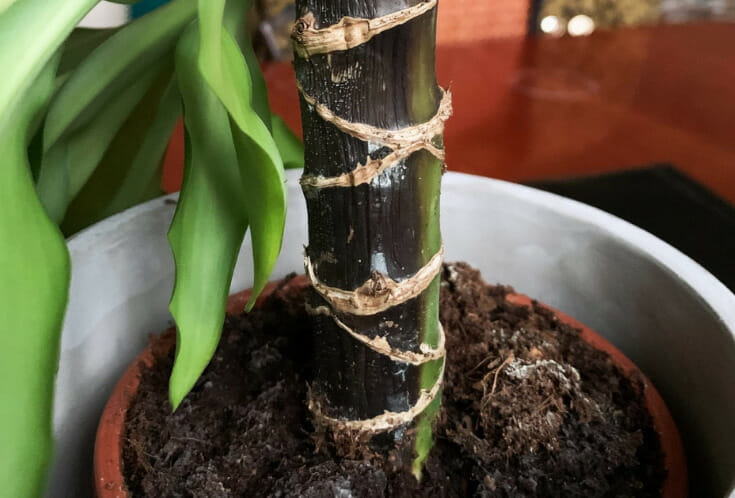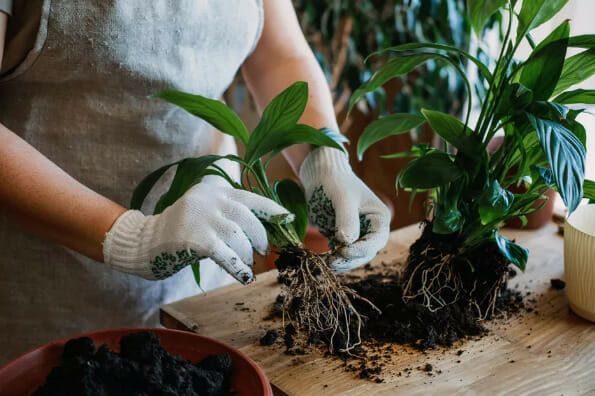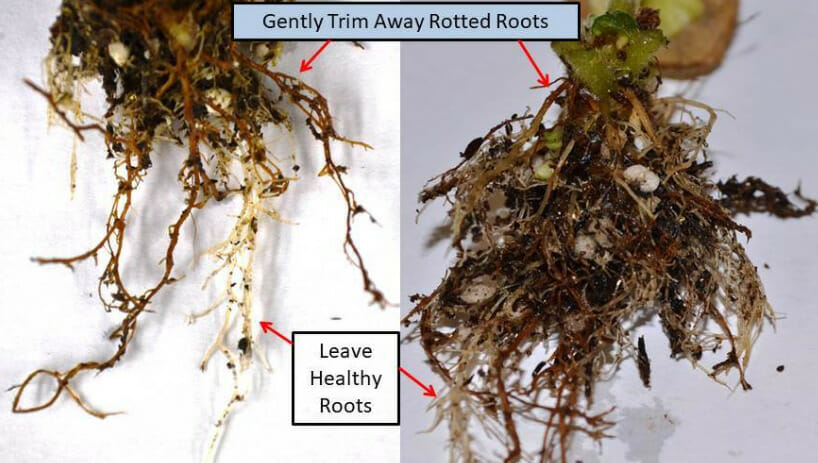How to Identify, Treat and Prevent Root Rot in Potted Plants?
Anyone with plants must have encountered root rot many times in their plant journey. Root rot usually occurs in potted plants as compared to garden plants. Since garden plants have good drainage, the risk of root rot minimizes. However, the potted plants in containers having insufficient drainage are more susceptible to root rot. But with careful investigation and timely action, you can fix and prevent root rot in the potted plants.

What is Root Rot?
As the name depicts, root rot is the rotting and crumbling of the roots due to any bacterial/fungal infection or other causes. The roots, a major source of nutrition for the plants, start decaying, and the plant eventually dies. The main reason for root rot is too much watering without sufficient drainage. Once the root decays, treating it is hard, but prevention is the best way to avoid root rot in potted plants.
Causes of Root Rot in the Potted Plants
There are two main causes of root rot in potted plants:
- Damp Soil
The most common cause of root rot is damp soil in the pot. It could be due to overwatering or lack of proper drainage in the pot. Sometimes the pot does not come with a drainage hole. While most of the time, the drainage holes are clogged with soil. In this way, excess water does not drain out of the soil.
The soil will remain damp and moist if you keep watering the plants without sufficient drainage. Roots that are in damp soil do not get proper air circulation. This can lead to root rot.

- Fungal Infection
Another reason for root rot is a fungal infection. Moist and soggy soil is ideal for the growth of fungus. Its pores multiply and start to spread in damp soil. With the advancement of fungus, it covers the roots and depletes them from essential nutrients and air. Hence, the healthy roots start to turn brown and mushy and eventually die due to a deficiency of nutrients.

Common Signs of Root Rot in Potted Plants
Since root rot occurs within the roots deep inside the pot, it is initially difficult to detect until the plants show some obvious signs. However, detailed insight into the root and soil condition can help detect this issue early, thus preventing its further progression. Plants show some early signs while the root is going towards decay. Some of the most common signs of root rot are
- Yellowing and Wilting Of Leaves
Either intentionally or not, leaves and flowers are the most looked after parts of the plants. Isn’t it? If that’s the case, these beautiful parts exhibit apparent signs of root rot that you can easily observe. The color of the leaves starts to turn yellow and become droopy.
Yellowing color and droopy leaves are usually because of overwatering. However, this may not necessarily be due to root rot. Since too much water is the major cause of root rot, it is an indicator that you should lessen the frequency of watering to eliminate the potential risk of root rot.

- Stunted Plant Growth
Healthy, fresh, and rapidly growing plants are every gardener’s dream. However, root rot can immensely block the expected growth of your plants. If you notice a sudden change in the growth rate of your plants, you certainly need to look for the cause, which might be root rot.
But remember that seasonal changes also moderately affect the plant’s growth. It is comparatively slow in winters and improves during spring and moderate summers.
- Black and Mushy Roots
Healthy roots appear white and somewhat green. Take the plant out from the pot and observe the roots precisely and carefully. You can also put it under running lukewarm water in the sink to get a clearer view of the roots. Make sure to gently brush your fingers into the roots while washing since they are already delicate and brittle.
The brownish color might be due to the surrounding soil and mud sticking to it. However, if the color is uniformly dark-brownish or black with a mushy root appearance, it is undoubtedly root rot.
Moreover, the rotten roots smell mushy and foul compared to healthy ones. Hence a confirmed root rot diagnosis can only be made once you have inspected the roots.

- Mold on the soil
Since fungal and bacterial infections are the leading causes of root rot, you might also see full-grown mold spores in the roots. This is a clear-cut sign of root-rot.
Is It Possible to Save My Rotten Plant?
Once you identify the root rot, the next question that comes to your mind certainly is: “Is it possible to save my rotten plant?“
The good news is that if you catch the root rot early, you can save your plant with immediate and appropriate action. Even if some of the roots are undamaged and healthy roots also exist, you can manage to revert the damage. However, if all the root system becomes mushy, then it is too late to save your plant, and there isn’t anything that you can do.
Fix Root Rot in the Potted Plants
Follow these steps to fix root rot in the potted plants:
1-Remove dying leaves
The first step in saving a plant from root rot is to remove all the brown dying leaves. The tip is to separate them as close as possible from the base.
2- Remove old soil
The next step is to move the plant from the rotting conditions, i.e., the wet and soggy soil in the case of a potted plant. Brush off as much set soil as possible. Be very careful while removing the soil, so the roots do not get affected too much while removing the soil.

3- Cut the Rotten Roots
You can see the roots when the plant is out of the soil. The healthy and alive roots have whitish color and little thread-like new branches. Whereas you can quickly identify the dead roots as they will appear brown-black and mushy.
Take a sharp tool like a shear, or a pair of scissors and start cutting the damaged roots. Avoid cutting the healthy roots to retain the maximum healthy portion. Put the roots under running water and gently wash the remaining roots to clean off any soil.
Now that your plant is left with less than half of the initial root cluster, the plant obviously would receive fewer nutrients. Hence it is recommended to clip some leaves, especially the yellow and wilting ones. This will reduce the burden on your plant and help it flourish better this time.
Ensure proper equipment sterilization after usage to prevent fungus or bacterial spread to the other plants.

4- Let the Soil Dry
If soggy and wet soil conditions are the reason for the root rot, avoid repeating this mistake. Let the soil air-dry for a while. Using artificial air from a fan is also an option.
5- Repot with New Soil
Once the plant is dry and fresh, repot it. Change the pot if your previous pot didn’t have a functional drainage hole. Please clean and dry the pot properly before placing the plant into it. Do Not use the previous soil and only use Fresh soil. This way, the old soil’s decay will not be transferred to the new pot. Most importantly, water the plant just enough to keep it alive and avoid over-watering it.

6- Treatment with Hydrogen Peroxide
As you know, hydrogen peroxide is a disinfectant, but it is also beneficial to treat various plant diseases. It has antifungal and antibacterial properties, which make it a powerful agent against root rot.
If you notice root rot symptoms in your plant due to a mild overwatering case, you can treat it without taking out the plant. However, if the decay has spread, remove the plant and treat the soil with hydrogen peroxide to sterilize it by killing pests and fungal spores. It will also provide air circulation to the roots facilitating them with required oxygen.
However, consider hydrogen peroxide a medicine which should not be used in higher concentrations or too frequently. As it will be damaging to the plant. Only use it when the disease has spread and is not treatable by home solutions.
Prevent Root Rot in the Potted Plants
It is better to take precautionary measures beforehand to avoid any hassle. This will reduce the chances of the root rot occurring in the first place.
1- Ensure Proper Drainage
Drainage is a critical factor in root-rot prevention. If your soil is continuously wet and soggy, it is home to various fungi and bacteria. So the plants are at significant risk of getting infected and rotten. Once it happens, there isn’t much you can do. Excessive water retention can cause depletion of the root’s oxygen supply, leading to plant death. Therefore, always get a pot with drainage holes in it and keep unclogging the hole once in a while to ensure maximum drainage.
2– Let the Roots Breathe
Maintain proper air circulation for the plant. Try to pick a spot where sunlight and air have easy and continuous access to the plant. This will help keep it dry and moisture-free. Occasionally dig into the soil properly to expose the lower parts as well. This will help keep all the soil aerated uniformly.
3- Avoid Unnecessary Watering
Overwatering is one of the most common mistakes that kill plants. Water only when you feel the plants are asking for it. Do not make assumptions about the plant’s water needs yourself. Thoroughly research each plant and soil type in your garden, and then decide to water them accordingly. If you have mistakenly over-watered, give a gap to let it dry before the next shift. Also, pay attention to their seasonal needs as well.

4- Routine Inspection
Even if the plants are healthy, try to check them every fortnight to rule out any signs, as mentioned above, of root rot and decay. Do not forget to pay attention to the lower parts of the leaves as well.
One helpful trick is to insert the finger some inches deep into the soil to access the moisture level. If it is wet, the plant retains moisture, and you need not water it immediately, even if the top layer appears dry enough.
You can occasionally check for the functionality of the pot’s drainage holes by tilting and inspecting the lower portion of the pot.
5- Isolation of the Plant if Infected
Usually, potted plants are planted alone in a pot. However, if there are more plants in a container and you see the infection or rot in one plant, separate it immediately. And repot only when you have gotten rid of all the causative agents.
6- Change The Soil
If the soil is significantly favorable for microbial growth, consider changing the soil for the plant. It is recommended to change it at least once or twice a year. The new and fresh soil would be fungus and bacteria-free, reducing the chance of recurrent root rot. The nutrient bulk and supply of fresh soil are also comparatively better, which will prove suitable for your newly rescued plant.

7- Fungicidal Spray
Neem oil solution is one of the best occurring fungicidal. You can spray neem oil mixed with water occasionally on the roots of the plants. It will prevent any fungal growth in the soil and be a great preventive measure for root rot.
Helpful Products for Root Rot
Although you can treat root rot effectively using easy home solutions, there are products available in the market which can assist you in fixing and preventing the root rot.
This ready-to-use soilless potting mix is perfect as it allows roots to breathe properly. Moreover, it is a well-draining and well-aerated potting mix. Hence, eliminating the most common problem of root rot.
This 100% neem oil is an excellent quality product as it kills the fungus and mold from soil which can be the potential cause of root rot. As an organic product, it is safe for humans and pets and can be used indoors.
It is a high purity food grade quality 3% hydrogen peroxide. You can use it to treat any disease like root rot in your plants.
Conclusion
One of the plant’s most unfortunate happenings, root rot, is undoubtedly a gardener’s worst nightmare. We hope the measures in this article for treating and preventing root rot in potted plants have been helpful to you. If you liked this article, visit our website for more articles.



